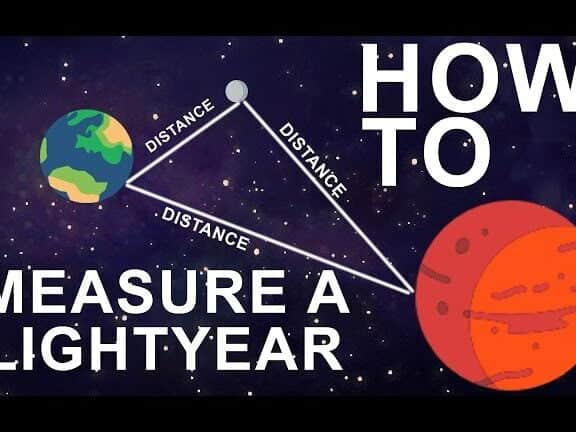One light-year (sv. yr., ly) corresponds to the distance that light travels in the span of one year. More precisely, it represents the distance a photon can travel through a vacuum without any gravitational interference, within a single tropical year during the epoch 1900.0 (equivalent to 31,556,925.9747 SI seconds; also referred to as Ephemeris Time). Given that the speed of light in a vacuum is precisely 299,792,458 m/s, it can be calculated that one light-year is exactly equal to 9,460,528,177,426.82 km (approximately 9.5 trillion kilometers). This definition is the most commonly used, although there are other definitions of a light-year that are based on a different length of the year (as there are several slightly varying definitions of a year). For instance, if we consider the Julian year (365.25 standard days of 86,400 SI seconds), the light-year would be 9,460,730,472,580.8 km, differing from the initial definition by merely 0.002%. Consequently, when making precise distance calculations, the light-year should only be used if there is prior agreement on the specific length of the year upon which this unit of measurement is based. Nevertheless, this distinction is not particularly critical when it comes to determining distances to objects beyond our solar system, where the light-year is commonly employed. Therefore,
1 light-year ≈ 9.461×1015 m ≈ 9.461 Pm (petameters) ≈ 63240 a. e. ≈ 0.3066 pc
The light-year and the parsec are utilized as units of measurement for determining the distance between far-off celestial objects. For instance, the distance to Proxima Centauri, the nearest star to the Sun, is 4.22 light-years. The distance to even the closest galaxies to the Milky Way (excluding a few galaxies in the local group) is already measured in millions of light-years.
Units such as the light second and light minute are sometimes used to measure distances within planetary systems, which are equal to the distance that light travels in a vacuum in 1 second and 1 minute, respectively (i.e. precisely 299,792,458 m and 17,987,547,480 m).
Transform Light Seconds to kilometers (Light Seconds to km):
Moreover, the calculator enables us to utilize mathematical equations. Consequently, it considers not only numerical values such as ‘(99 * 7) Light Seconds’. You can even incorporate multiple units of measurement directly in the conversion field. For instance, an example of such a combination could be ‘774 Light Seconds + 2322 kilometers’ or ’25mm x 78cm x 98dm = ? cm^3′. Naturally, the units of measurement combined in this manner must align and be logically applicable within the given combination.
Light Second
The light second is a unit of measurement used in astronomy, telecommunications, and relativistic physics. It represents the distance that light can travel in one second when moving through free space. This equates to approximately 299,792,458 meters (or 983,571,056 feet).
Similar to how the second is used as a base unit for measuring time, the light second can be used as a base unit for measuring length. This allows for the creation of other units, such as the light nanosecond (which is approximately 299.8 mm or just under one international foot) and the light minute, light hour, and light day. These units are occasionally utilized in popular science publications. The more commonly known light year is currently defined as 31,557,600 light seconds. This definition is based on a Julian year, which consists of exactly 365.25 days, with each day consisting of exactly 86,400 SI seconds. [1]
Application in telecommunications
When it comes to communication signals on Earth, their speed is typically much slower compared to the speed of light in outer space. This difference in speed is taken into account when planning telecommunications networks.
- A light nanosecond is approximately 300 millimeters (299.8 mm, which is 5 mm less than one foot[2]). This limitation affects the speed of data transmission between various components of a large computer.
- A light microsecond is equivalent to about 300 meters.
- The average distance between opposite sides of the Earth is 66.8 light milliseconds. 1,337 Light milliseconds (in low Earth orbit) to 119.4 light milliseconds (in geostationary orbit) from the Earth’s surface. As a result, there will always be a minimum delay of a quarter of a second (119.4 ms times 2) when communicating through a geostationary satellite; this delay is hardly noticeable in a transoceanic telephone conversation transmitted via satellite. The response will also be delayed by a quarter of a second, and this delay is clearly visible during interviews or discussions on television when transmitted via satellite.
Application in astronomy
The light second serves as a convenient unit of measurement for distances within the inner solar system due to its close correspondence with the radiometric data used for their determination. However, there is a small correction for the effects of relativity when considering Earth observers. The light second is particularly significant in calculating modern ephemerides, which are tables indicating the positions of planets. In astronomical constant tables, it is often referred to as “light time per unit distance” and its currently accepted value is 499.004 786 385 (20) s. [3] [4]
- The average diameter of the Earth is approximately 0.0425 light seconds.
- The average distance between the Earth and the Moon (lunar distance) measures around 1.282 light seconds.
- The distance between the Earth and the Sun, known as an astronomical unit, is equivalent to 499.0 light seconds.
In popular science publications, it is possible to calculate multiples of a light second. However, these calculations are more commonly found in popular science publications rather than research papers. For instance, a light minute is equal to 60 light seconds, and the average distance between the Earth and the Sun is approximately 8.317 light minutes.
Online calculator. Unit conversion. Light second
Light second is a unit of measurement for distance in astronomy. 1 light second is equal to 299,792.458 kilometers.
This online calculator enables you to effortlessly convert distances from light seconds to various other units of length and distance.
Unit converter for length. Light second
To convert light seconds to other units of measurement:
- Enter the specified value of light seconds.
- Click the “Convert” button
- Done! The length value will be displayed in other units.
You can input numbers or fractions (-2.4, 5/7, . ). For more information, please refer to the guidelines for entering numbers.
Metric system – refers to the international decimal system of units based on the meter and kilogram.
The English (American) system of measurement is based on British measures. Since 1958, the exact conversion rate to the metric system has been used: 1 inch = 2.54 centimeters.
According to the current definition, an international nautical mile is equal to precisely 1,852 meters. While the nautical mile is not considered an SI unit, it has been allowed for use by the General Conference on Weights and Measures, although it is not recommended. The international nautical mile is equivalent to 10 cable meters or one-third of a nautical league.
Any inappropriate comments will be removed and their authors will be added to the blacklist!
Welcome to OnlineMSchool.
My name is Dovzhik Mikhail Viktorovich. I am the owner and writer of this website. I have created all the theoretical material and developed online exercises and calculators that you can utilize to enhance your math skills.
A light second is a unit of measurement used in astronomy, telecommunications, and relativistic physics. It is defined as the distance that light travels through empty space in one second and is precisely equal to 299,792,458 meters (983,571,056 feet).
- 1 Applications in telecommunications
- 2 Usage in astronomy
- 3 Further Information
- 4 Citations
Applications in telecommunications
Communication signals on Earth rarely travel at the exact speed of light in outer space. Distances in fractions of a light second are beneficial for the planning of telecommunications networks.
- One light nanosecond is approximately 300 millimeters (299.8 mm, 5 mm less than one foot), which restricts the speed of data transmission between different components of a large computer.
- One light microsecond is about 300 meters.
- The average distance over land between opposite sides of the Earth is 66.8 light milliseconds.
- Communications satellites usually have different distances from the Earth’s surface, ranging from 1.337 light milliseconds (in low-Earth orbit) to 119.4 light milliseconds (in geostationary orbit). As a result, there is always a minimum delay of a quarter of a second (119.4 ms times 2) when transmitting data through a geostationary satellite. This delay becomes noticeable during a telephone conversation across the ocean that is routed through a satellite. Similarly, there is a quarter-second delay in receiving a response, which becomes apparent during a television interview or discussion that is transmitted via satellite.
Applications in the field of astronomy
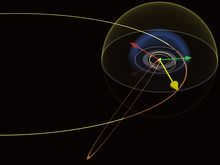 The size of the yellow shell, which corresponds to a distance of one light day from the Sun, is being compared to the positions of Voyager 1 and Pioneer 10 (indicated by red and green arrows, respectively). It is larger than the boundary of the heliosphere (marked by the blue shell), but smaller than the orbit of comet Hale-Bopp (represented by the faint orange ellipse below). Feel free to click on the image to enlarge it and explore other scales.
The size of the yellow shell, which corresponds to a distance of one light day from the Sun, is being compared to the positions of Voyager 1 and Pioneer 10 (indicated by red and green arrows, respectively). It is larger than the boundary of the heliosphere (marked by the blue shell), but smaller than the orbit of comet Hale-Bopp (represented by the faint orange ellipse below). Feel free to click on the image to enlarge it and explore other scales. 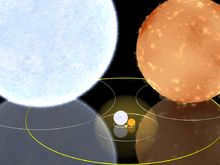 The faint yellow sphere centered around the Sun has a radius equivalent to one light minute. To provide a sense of scale, Rigel (the blue star in the upper left) and Aldebaran (the red star in the upper right) are also included. Additionally, the large yellow ellipse denotes the orbit of Mercury.
The faint yellow sphere centered around the Sun has a radius equivalent to one light minute. To provide a sense of scale, Rigel (the blue star in the upper left) and Aldebaran (the red star in the upper right) are also included. Additionally, the large yellow ellipse denotes the orbit of Mercury.
The light second is a convenient measurement unit for distances in the inner solar system as it closely matches the radiometric data used to determine them. (For an observer on Earth, this coincidence is slightly inaccurate due to a correction for the effects of relativity.) The value of the astronomical unit (approximately the distance between the Earth and the Sun) in terms of light seconds is the fundamental measurement unit for calculating modern ephemerides (tables of planetary positions). It is commonly listed in tables of astronomical constants as “light time for a unit of distance”, and its currently accepted value is 499.004786385 (20) seconds.
- The average diameter of the Earth is approximately 0.0425 light seconds.
- The average distance between the Earth and the Moon is approximately 1.282 light seconds.
- The Sun’s diameter is approximately 4.643 light seconds.
- The average distance from the Earth to the Sun is 499.0 light seconds.
There are various definitions of light seconds, although they are more commonly used in popular science publications rather than in research papers. For instance, a light minute is equivalent to 60 light seconds, and the average distance from the Earth to the Sun is 8.317 light minutes.
Related Articles
Exchange technology, algorithmic trading, Java and programming

Time
- 00:00:01 – 1 (sec.) second;
- 00:00:00.001 – 1 millisecond (millisec.) – one thousandth of a second – 10 -3 ;
- 00:00:00.000,001 – 1 microsecond (microsec.) – one millionth of a second – 10 -6 ;
- 00:00:00.000,000,001 – 1 nanosecond (nanosec.) – one billionth of a second – 10 -9 ;
- 00:00:00.000,000,000,001 – 1 picosecond – (picosec.) – one trillionth of a second – 10 -12 .
| 1 | 60 | 60,000 | 3,600,000 | ||
| 1 | 60 | 3,600 | 3,600,000 | ||
| 1 | 24 | 1,440 | 86,400 | 86,400,000 | |
| 1 | 7 | 168 | 10,080 | 604,800 | 604,800,000 |
Speed of light: the relationship between distance and time
- 1 foot (30 cm) of cable = 1 nanosecond;
- 1 meter of cable = 3.3 nanoseconds;
- 1 kilometer = 3.3 microseconds (1 kilometer of fiber optics experiences a 70% deceleration and takes 4.76 microseconds);
- 10 kilometers = 33 microseconds (10 kilometers of fiber optics experiences a 70% deceleration and takes 49 microseconds);
- from the geostationary orbit to Earth – a distance of 35,786 kilometers takes 119 milliseconds, which is equivalent to 0.12 seconds.
Velocity of light: relationship between time and distance
- 1 millisecond corresponds to the length of 300 kilometers of cable, which is equivalent to 300,000 meters of cable;
- 1 microsecond corresponds to the length of 300 meters of cable, which is equivalent to 30,000 centimeters of cable;
- 1 nanosecond corresponds to the length of 1 foot (0.3 meters, or 30 centimeters) of cable – this is the time it takes for a 1GHz processor to complete one clock cycle;
- 1 picosecond corresponds to the length of 0.3 feet (0.1 meter, or 10 centimeters) of cable.
Speed of light and microprocessor
1 MHz – 1 million clock cycles per second – 1 processor clock cycle in 1 microsecond.
1 GHz – 1 billion cycles per second – 1 processor clock in 1 nanosecond.
A modern microprocessor typically operates at a frequency of 3 GHz or higher. This means that the processor can complete approximately 3 clock cycles in 1 nanosecond. In other words, it takes only 0.3 nanoseconds (or 300 picoseconds) for one clock cycle to complete. During this time, light can travel through a distance of 10 cm in a vacuum. However, in the medium of the processor crystal and copper conductors, the speed of light is 25% slower than in a vacuum.
The Relationship Between Speed of Light and Network Latency
Network engineers in the financial technology industry constantly grapple with the concept of latency, which is directly tied to the speed of light. According to the principles of physics, specifically the Theory of Relativity, information cannot be transmitted faster than the speed of light. This means that the maximum speed at which data can travel is 300,000 km/sec or 300 kilometers per millisecond (299,792,458 meters per second). As a result, when transmitting data over a distance of 300 kilometers, there is an unavoidable delay of 1 millisecond.
- It’s not the physical distance that matters, but rather the total distance the signal must travel through all the connections to reach its destination, which can be significantly greater than the actual geographic distance.
- The transmission medium also imposes its own limitations on the signal. The speed of light in a vacuum is 300,000 kilometers per second. When light propagates in air at normal temperature (273.15 K) and normal atmospheric pressure (0.986 atm), it is 1.0003 times slower than in a vacuum. In modern networks, signals are transmitted through either copper or fiber optic cables. In fiber optic cables, depending on their quality, light propagates at a speed of 72-75% of the reference speed. In copper cables, it is 60-70% of the reference speed.
If your application is located closer to the exchange, your orders will be able to reach its trading engine faster. Therefore, if your trading strategy is sensitive to latency, the best solution is to colocate your application in the exchange’s data center. Alternatively, you can choose proximity hosting in a third-party data center.
In this video, Admiral Grace Hopper provides a clear explanation of what one nanosecond is – it is the time it takes for light to travel one billionth of a second. She also explains the concept of one microsecond, which is one millionth of a second.
[See also: How communication cables connecting the world’s financial centers span continents]
Did You Know?
The flapping of a Drosophila fruit fly wing occurs in just 4 milliseconds, which is equivalent to 250 times per second.
On average, a human eye blink lasts for about 100-150 milliseconds.
The human body has different response rates to various stimuli:
- Response to light takes approximately 100-200 milliseconds.
- Response to sound occurs within 120-150 milliseconds.
- Response to an electrodermal stimulus takes about 100-150 milliseconds.
It only takes 200 milliseconds for a signal to travel from a satellite in geostationary orbit around the Earth and back.
According to von Neumann, 1 microstage is equal to 52 minutes. This means that 1 microstage is calculated as 100 years multiplied by 365 days, then multiplied by 24 hours and finally multiplied by 60 minutes, resulting in 52,560,000 minutes divided by 1,000,000.
Contemporary stock exchange systems have the capability to execute a single transaction (matching a buy order with a sell order) in under 100 microseconds (and some of the most cutting-edge ones can do it even faster). It is physically impossible for a human being to respond to an event happening at such an accelerated pace. As a result, human traders are being substituted by computers in trading rooms, leading to the increasing prominence of electronic and automated trading. In this type of trading, operations are pre-programmed and executed by computers in an automated manner, without any direct human intervention.
The speed of light, known as c, is a fundamental constant in physics. It is measured to be approximately 299,792,458 meters per second, with an accuracy of ±1.2 m/s [1]. This means that light can travel a distance of 300,000 kilometers in just one second. To put this into perspective, if you were on the Moon and shone a bright light towards Earth, it would take approximately 1.25 seconds for the light to reach us.
The accuracy of this speed value is due to an international agreement that defines the meter as the distance that light travels in a vacuum in 1/299792458 seconds.
Keep in mind. The velocity of light c is precisely determined as 299,792,458 meters per second. Nothing surpasses the speed of light.
How extraordinary is the velocity of light?
It is challenging to comprehend the enormity of the velocity of light. It is preferable to envision it in relation to speeds that are more familiar. In the subsequent table, contemplate how swiftly other things in our daily lives move in comparison to the velocity of light.
| Object | Speed in m/s (rounded up) |
| Individual | 1.5 |
| Racing car | 100 |
| Sound waves | 343 |
| Supersonic aircraft | 400 |
| Velocity of light | 300,000,000 |
However, the velocity of light in a vacuum (like the vastness of space) is the following. If light travels through a substance like air, its velocity can be significantly diminished.
The velocity of light is the ultimate velocity for all substances and information. Along regular paths, nothing surpasses the speed of light in a vacuum, denoted as c. This implies that not just light, but everything else is governed by this velocity limitation. This encompasses electromagnetic radiation and gravitational waves, for instance. These waves and particles journey at the velocity of light, regardless of their source’s velocity and direction. The same applies to a moving object. For instance, if a train is moving with its headlights on, the light will still travel at the velocity of light, irrespective of the train’s speed. Particles and substances with non-zero mass can approach the velocity of light, but never actually attain it.
When light travels through transparent media like air or glass, its speed is slower compared to its speed in a vacuum. The same principle applies to electromagnetic waves in conductors; they also travel slower than the speed of light. The ratio between the speed of light (c) and the speed in the medium (v) is known as the index of refraction (n = c / v).
The speed of light in air.
In air, the index of refraction for visible light is approximately 1.0003. As a result, light travels about 90 kilometers per second slower in air than in a vacuum, which is equivalent to c / 1.0003 ≈ 299910 km/s.
The speed of light in water.
In water, the refractive index is around 1.3. Consequently, the speed of light decreases to approximately 230,769 kilometers per second, which is equal to c / 1.3 ≈ 230,769 km/s.
The speed of light in glass.
Glass possesses a refractive index of 1.5. If we calculate this value as before, we obtain a velocity of approximately 200,000 kilometers per second, which is equivalent to c / 1.5 ≈ 200,000 km/s.
Determining the velocity of light
When you switch on a light in your home, it appears as though the light instantaneously fills the room. Nevertheless, when observing light over great distances and with more precise measuring instruments than the naked eye, the finite speed of light becomes evident.
There exist numerous experiments to demonstrate this phenomenon. Nonetheless, one fascinating approach involves employing our moon as a target.
Consider the scenario in which you have positioned a mirror on the surface of the Moon. You then employ a laser to direct light from Earth onto that mirror, and wait to observe how long it takes for the reflected light to reach you. Only after approximately 2.5 seconds will you perceive the flash from the mirror.
Thus, at what velocity v is the light emitted from your laser traveling?
It is possible to calculate it. The distance between the Moon and Earth is 384,400 kilometers. To cover this distance, your laser light needs to travel twice – once from your location to the Moon, and then back from the Moon to you. It takes the laser approximately 2.5 seconds to cover this entire distance.
The velocity can be determined using the formula v = distance / time = 2 * 384,400 km / 2.5 s = 307,520 km/s.
Although this value is slightly different from the actual speed of light, which is about 300,000 kilometers per second, it is very close. With more precise measuring instruments, the speed of light can be determined more accurately.
By the way, it takes even longer for light to travel from the Sun to the Earth. On average, it takes around 8 minutes and 17 seconds for light emitted from the Sun to reach us on Earth.
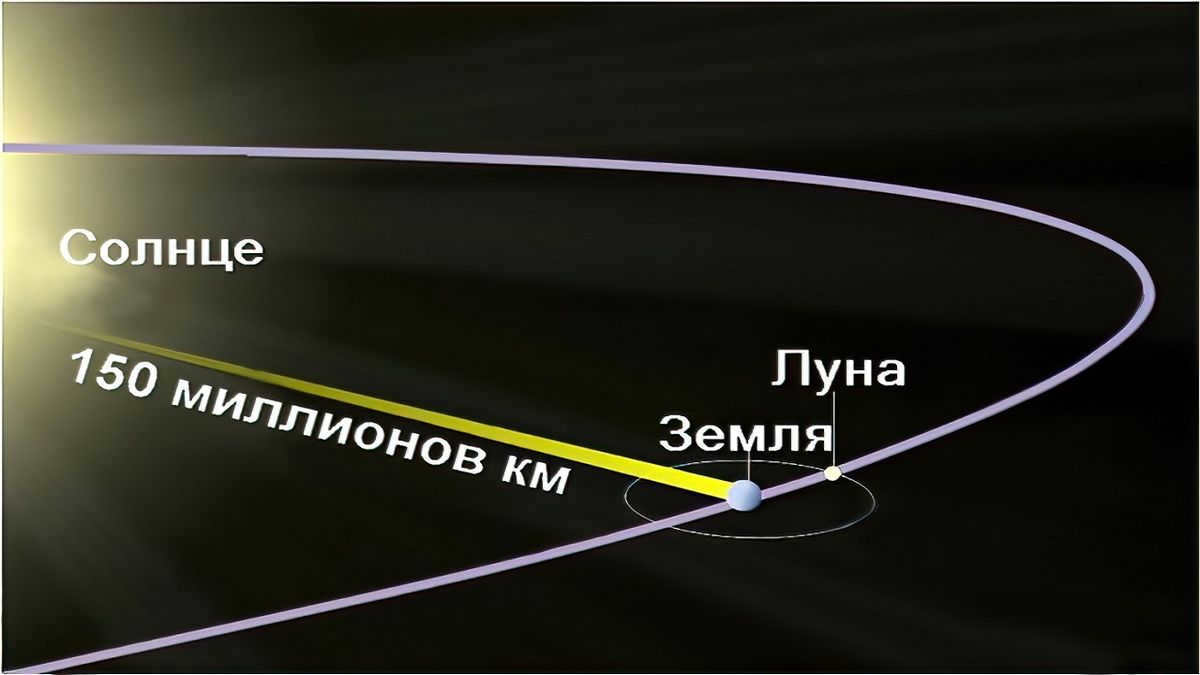
The determination of the speed of light has had a significant impact on the field of science. It not only provided an understanding of the nature of light, but also established the fundamental limitation on the maximum speed of any object in the universe – the speed of light in a vacuum. This fundamental insight was made possible by the development of the theory of relativity.
Furthermore, this discovery revolutionized our understanding of the physical world and laid the foundation for many scientific advancements. It opened up new avenues of research and sparked new questions about the fundamental nature of space and time.
Units of measurement
Now you have observed that speed is expressed in meters per second, as well as in kilometers per second or kilometers per hour. By performing simple calculations, you can personally convert the values to the appropriate units.
To simplify the calculation, let’s round up and assume that the speed of light is 300,000,000 meters per second (300,000,000,000 m/s).
The speed of light is in km / s .
The conversion to kilometers per second is relatively straightforward. There are 1,000 meters in one kilometer. You are aware that light travels at 300,000,000,000 meters per second, so 300,000,000,000 meters / 1000 = 300,000 km.
This implies that in one second, your light covers a distance of 300,000 kilometers.
The speed of light is in km / h .
Now that you have an understanding of the distance that light travels in one second, let’s extrapolate that to an hour. We know that there are 60 minutes in an hour and 60 seconds in one minute, which means there are 3600 seconds in one hour.
So, if we take the distance of light traveled in one second, which is 300,000 km, and multiply it by 3600 (the number of seconds in one hour) and divide it by 3600 (to account for the conversion of seconds to seconds), we get 1,080,000,000,000 km/h.
Therefore, we can conclude that light travels at a speed of approximately 1,080,000,000,000,000,000 km/h (kilometers per hour) in a vacuum.
The velocity of light in electrodynamics
Traditional physics portrays light as an electromagnetic wave. Furthermore, Maxwell’s equations depict the classical behavior of electromagnetic waves.
Maxwell’s laws anticipate waves in empty space with a velocity: c = 1 / ε0 * μ0 where ε0 represents the electric constant and μ0 signifies the magnetic constant.
In contemporary quantum physics, the theory of quantum electrodynamics (QED) elucidates the electromagnetic field. In this scenario, light is the fundamental disturbance (also known as a quantum) of the electromagnetic field. This disturbance materializes as a photon. Within the framework of QED, photons are weightless particles. Consequently, in accordance with the special theory of relativity, they traverse the vacuum at the velocity of light.
List of used resources
- Wikipedia
- Physics. Grade 11: textbook for general educational institutions: basic and profile levels / G. Y. Myakishev, B. B. Bukhovtsev, V. M. Charugin; edited by V. I. Nikolaev, N. A. Parfentieva. I. Nikolaev, N. A. Parfentieva. – 19th edition. – Moscow : Prosveshchenie, 2010. – 399 pages.
- Kasyanov V. A. Physics. 11 kl.: Textbook for general educational institutions. – Moscow : Drofa, 2005.
Share on social media
© 2022 ASUTPP Information Internet site
The content on this website is intended for informational purposes only. It is always advisable to seek advice from qualified professionals for electrical installation projects.
Learn more
div data-code=’PGRpdiBjbGFzcz0nY29kZS1ibG9jayBjb2RlLWJsb2NrLTcnIHN0eWxlPSdtYXJnaW46IDhweCAwOyBjbGVhcjogYm90aDsnPgo8IS0tIFlhbmRleC5SVEIgUi1BLTEzNjk1MzgtNjcgLS0+CjxzY3JpcHQ+CnNldFRpbWVvdXQoZnVuY3Rpb24oKSB7CndpbmRvdy55YUNvbnRleHRDYi5wdXNoKCgpPT57CiAgWWEuQ29udGV4dC5BZHZNYW5hZ2VyLnJlbmRlcih7CiAgICB0eXBlOiAnZnVsbHNjcmVlbicsICAgIAogICAgcGxhdGZvcm06ICd0b3VjaCcsCiAgICBibG9ja0lkOiAnUi1BLTEzNjk1MzgtNjcnCiAgfSkKfSkKfSwgMjAwMCk7Cjwvc2NyaXB0PgoKCjxicj4KPCEtLSBZYW5kZXguUlRCIFItQS0xMzY5NTM4LTY2IC0tPgo8ZGl2IGlkPSJSLUEtMTM2OTUzOC02NiI+PC9kaXY+CgoKPHNjcmlwdD4KICAgIHdpbmRvdy55YUNvbnRleHRDYi5wdXNoKCgpID0+IHsKICAgICAgICBZYS5Db250ZXh0LkFkdk1hbmFnZXIucmVuZGVyRmVlZCh7CiAgICAgICAgICAgIGJsb2NrSWQ6ICdSLUEtMTM2OTUzOC02NicsCiAgICAgICAgICAgIHJlbmRlclRvOiAnUi1BLTEzNjk1MzgtNjYnCiAgICAgICAgfSkKICAgIH0pCiAgICB3aW5kb3cueWFDb250ZXh0Q2IucHVzaCgoKSA9PiB7CiAgICAgICAgWWEuQ29udGV4dC5BZHZNYW5hZ2VyLnJlbmRlcih7CiAgICAgICAgICAgIGJsb2NrSWQ6ICdSLUEtMTM2OTUzOC02NScsCiAgICAgICAgICAgIHR5cGU6ICdmbG9vckFkJyAvLyB0b3BBZCDQuNC70LggZmxvb3JBZAogICAgICAgIH0pCiAgICB9KQogICAgY29uc3QgZmVlZCA9IGRvY3VtZW50LmdldEVsZW1lbnRCeUlkKCdSLUEtMTM2OTUzOC02NicpOwogICAgY29uc3QgY2FsbGJhY2sgPSAoZW50cmllcykgPT4gewogICAgICAgIGVudHJpZXMuZm9yRWFjaCgoZW50cnkpID0+IHsKICAgICAgICAgICAgaWYgKGVudHJ5LmlzSW50ZXJzZWN0aW5nKSB7CiAgICAgICAgICAgICAgICBZYS5Db250ZXh0LkFkdk1hbmFnZXIuZGVzdHJveSh7YmxvY2tJZDogJ1ItQS0xMzY5NTM4LTY1J30pOwogICAgICAgICAgICB9CiAgICAgICAgfSk7CiAgICB9OwogICAgY29uc3Qgb2JzZXJ2ZXIgPSBuZXcgSW50ZXJzZWN0aW9uT2JzZXJ2ZXIoY2FsbGJhY2ssIHsKICAgICAgICB0aHJlc2hvbGQ6IDAsCiAgICB9KTsKICAgIG9ic2VydmVyLm9ic2VydmUoZmVlZCk7Cjwvc2NyaXB0PjwvZGl2Pgo=’ data-block=’7’>


Outer space
From a young age, many individuals are aware of the concept of the “speed of light.” It is commonly known that light travels at an incredibly fast pace. However, not everyone possesses a comprehensive understanding of this phenomenon.
During a thunderstorm, it is often observed that there is a delay between the appearance of lightning and the subsequent sound of thunder. Lightning tends to reach us quicker, indicating that it possesses greater velocity compared to sound. But what does this have to do with lightning? What exactly is the speed of light, and how is it measured?
What is the velocity of light?
First, let’s gain an understanding of the velocity of light. In scientific terms, it is the measure of how quickly rays travel through a vacuum or the atmosphere. It is also important to comprehend what light itself is. Light is a form of radiation that is detected by the human eye. The speed of light, as well as its other characteristics such as refraction, depend on environmental conditions.
Fascinating tidbit: It takes light approximately 1.25 seconds to journey from Earth to its natural satellite, the moon.
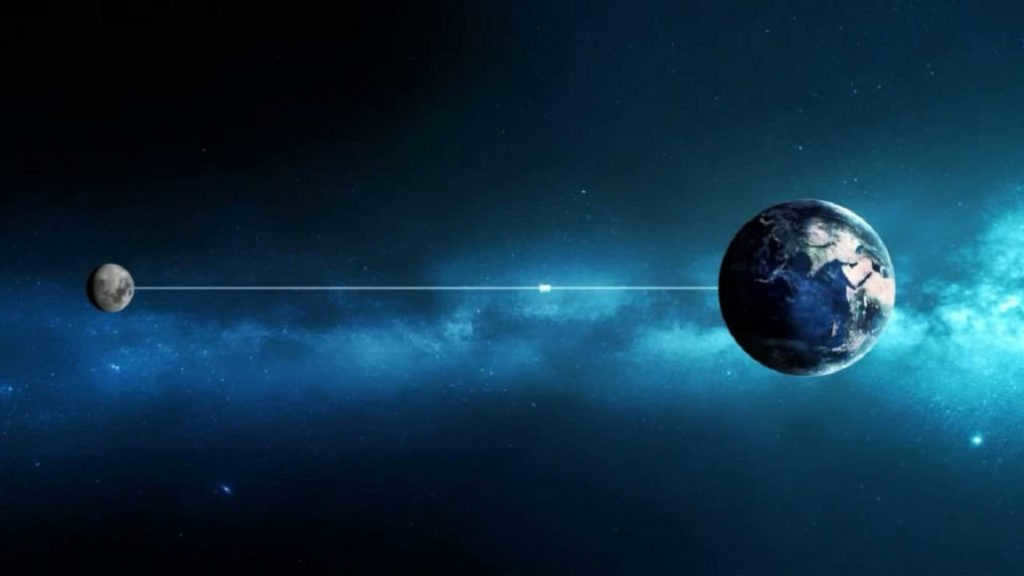
How is the speed of light defined?
Put simply, the speed of light is the amount of time it takes for a beam of light to travel a certain distance. Time is typically measured in seconds, although some scientists may use alternative units of measurement. Distance is also measured in various ways, but it is commonly expressed in meters. Therefore, the speed of light is typically given in meters per second. In physics, this value is considered to be constant for a given phenomenon.
To simplify the concept, let’s consider the following illustration. Imagine a cyclist who is traveling at a velocity of 20 km/h. Now, suppose he intends to catch up with a car driver who is moving at a speed of 25 km/h. If we calculate the difference, we can see that the car is traveling 5 km/h faster than the cyclist. However, the scenario changes when it comes to light rays. Regardless of how swiftly the individuals in question are moving, the speed of light remains constant relative to them.
What is the velocity of light?
The speed of light can vary depending on the medium it travels through. Factors such as the material it passes through can affect the velocity of light. While the speed of light remains constant at approximately 299,792 kilometers per second in a vacuum, it changes when it encounters different substances.
Light moves slower when it passes through materials like glass, water, and air. This change in velocity is measured using a refractive index, which indicates how much the material slows down the speed of light. For example, glass has a refractive index of 1.5, meaning that light travels through it at around 200,000 kilometers per second. Water has a refractive index of 1.3, while air has a refractive index slightly greater than 1, causing only a slight decrease in the speed of light.
As a result, when light passes through a medium such as air or liquid, its velocity decreases, becoming slower than in a vacuum. For instance, in different bodies of water, the speed of light is only 0.75 times its speed in space. Additionally, at a standard pressure of 1.01 bar, the velocity decreases by 1.5-2%. Therefore, the speed of light varies depending on the environmental conditions under terrestrial circumstances.
This phenomenon is known as refraction, which refers to the bending of light. Refraction of light is widely utilized in various inventions, such as refractor telescopes with optical systems. Binoculars and other equipment also make use of optics and rely on the principles of refraction.
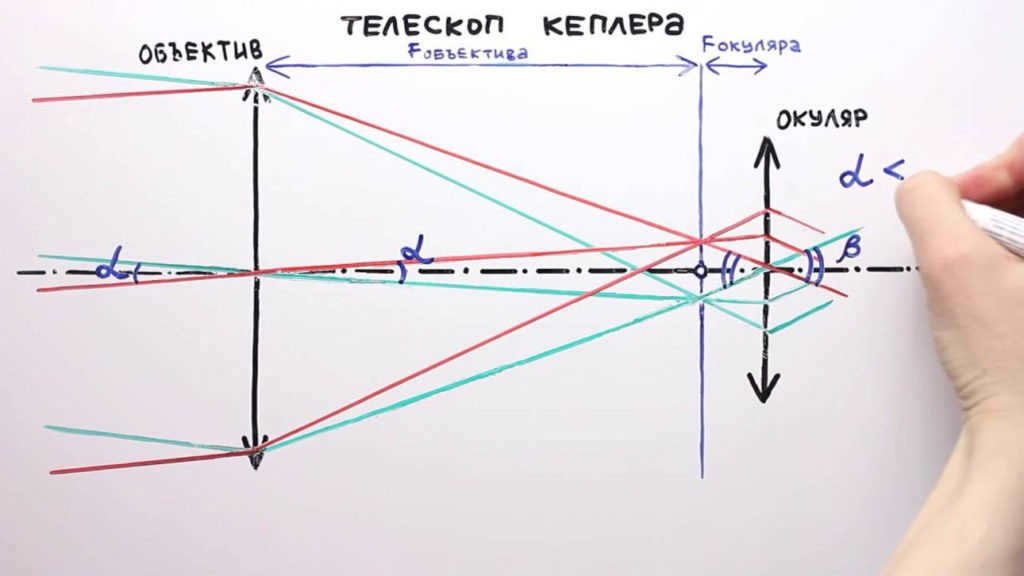
Diagram of a refractor telescope
Generally, the beam of light is not easily refracted when it travels through regular air. However, when it passes through a specially designed glass, its speed is reduced to approximately 195 thousand kilometers per second. This is a decrease of almost 105 thousand kilometers per second compared to the constant speed.
Over the years, physicists have amassed a wealth of knowledge about the velocity of light. Presently, the most precise measurement for the speed of light is 299,792 kilometers per second. This constant was established back in 1933 and remains valid to this day.
However, in recent times, determining this value has become more challenging due to errors in meter measurements. Nowadays, the meter itself is intricately tied to the speed of light. It represents the distance that light rays travel in a specific number of seconds – 1/speed of light.
What is the velocity of light in a vacuum?
Due to the absence of any external influences in a vacuum, the velocity of light remains constant and does not vary like it does on Earth. The velocity of light in a vacuum is 299,792 kilometers per second. This speed is considered to be the ultimate limit, with nothing in the universe capable of surpassing it, not even celestial bodies that travel at great speeds.
For instance, the Boeing X-43 fighter jet, which exceeds the speed of sound by nearly 10 times (over 11 thousand kilometers per hour), is slower than a beam of light. The latter travels more than 96 thousand kilometers per hour faster.
What methods were used to measure the speed of light?
Various methods were employed by early scientists in their attempts to measure the speed of light. During antiquity, it was widely believed that the speed of light was infinite and therefore impossible to measure. This perspective remained dominant until the 16th and 17th centuries, when new scientists emerged with the belief that light had a finite speed that could be measured.
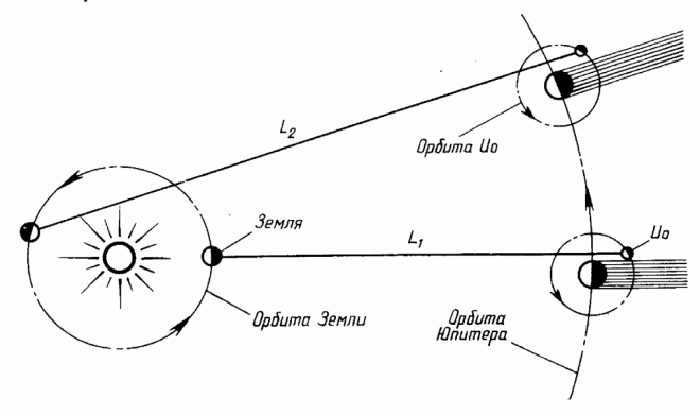
Olaf Rømer, a well-known Danish astronomer, made significant advancements in our understanding of the speed of light. He made a groundbreaking observation that the eclipse of Jupiter’s satellite appeared to be delayed. This observation had previously gone unnoticed by others. Intrigued by this phenomenon, Rømer decided to calculate the speed of light.
He proposed an estimated speed of approximately 220,000 kilometers per second. Subsequently, a British scientist named James Bradley took on the task of further investigating this topic. While Bradley’s calculations were not entirely accurate, they brought us closer to the current understanding of the speed of light.
The Italian scientist astounded his contemporaries with his ingenious and straightforward experiment. Using only ordinary instruments, he was able to measure the speed of light.
Together with his assistant, he climbed nearby hills, first calculating the distance between them. They equipped lanterns with adjustable shutters and took turns opening and closing them. By timing the alternations, they attempted to determine the speed of light. Galileo and his assistant knew in advance the delay between each shutter movement. As one opened, the other would follow suit.
Unfortunately, the experiment proved unsuccessful. To achieve accurate results, the scientists would have needed to stand millions of kilometers apart.
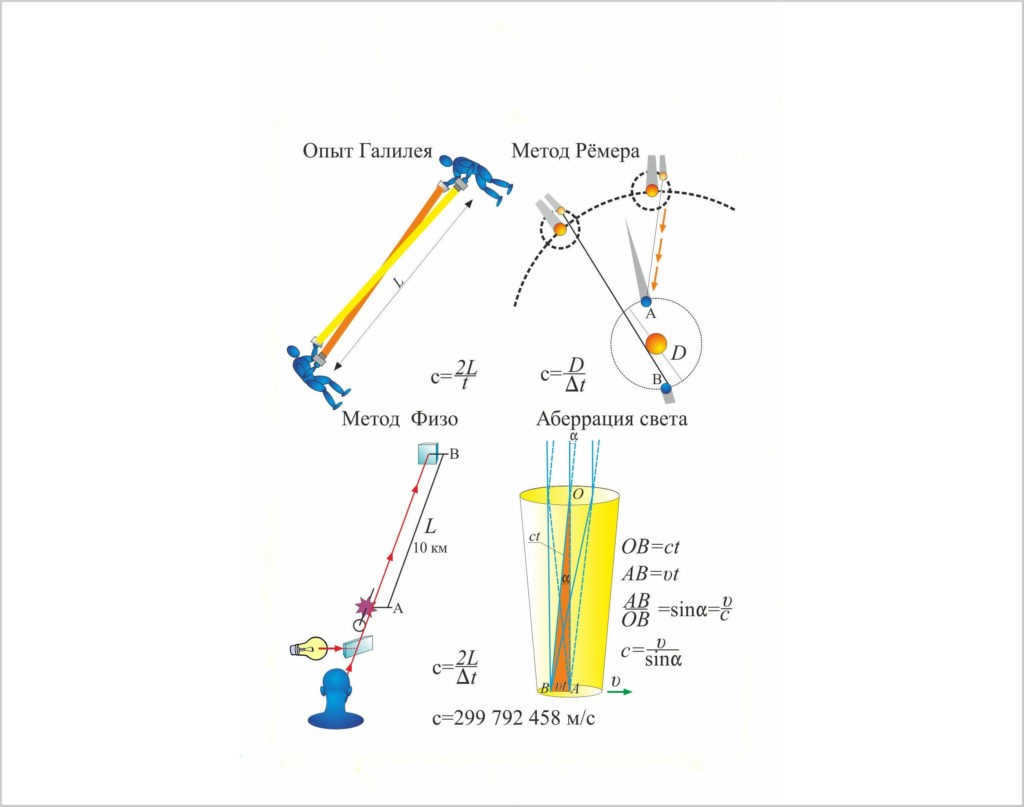
Römer and Bradley's experiment
This particular study has already been briefly mentioned earlier. It stands out as one of the most innovative experiments of its time. Römer utilized his expertise in astronomy to assess the velocity of light rays. This groundbreaking experiment took place during the 76th year of the 17th century.
The researcher meticulously observed Io, which is one of Jupiter’s moons, through a powerful telescope. What he discovered was a fascinating pattern: as our planet moved farther away from Jupiter, the delay in the occurrence of Io’s eclipse became more pronounced. The longest delay recorded was approximately 21 to 22 minutes.
James Bradley made a valuable contribution to scientific research in the 18th century. He employed the concept of aberration, which refers to the alteration in the location of celestial bodies as a result of Earth’s orbit around the sun. By measuring the angle of aberration and taking into account the velocity of our planet, Bradley determined a speed of 301 thousand kilometers per second.
The Fizeau Experiment
Roemer and James Bradley faced skepticism from both researchers and the general public regarding their findings. Nevertheless, their results stood the test of time and remained relevant for more than a century. In the 19th century, Paris-based scientist Armand Fizeau made further advancements in measuring this phenomenon. He employed the rotating shutter technique, similar to how Galileo Galilei and his assistant conducted their experiments. Rather than observing celestial bodies directly, Fizeau conducted laboratory investigations.
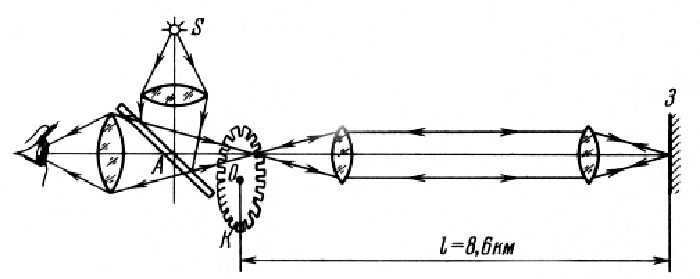

The experiment was based on a straightforward principle. A mirror was used to reflect a beam of light, which then passed through the cogs of a wheel. The light then hit another reflecting surface, located 8.6 km away. By increasing the speed of the rotating wheel, the scientist was able to make the beam visible in the next gap. After performing calculations, the scientist obtained a result of 313 thousand km/sec.
Subsequently, the experiment was replicated by Leon Foucault, a French physicist and astronomer, who achieved a result of 298 thousand km/sec. This was considered the most accurate result at that time. Later measurements were conducted using lasers and masers.

